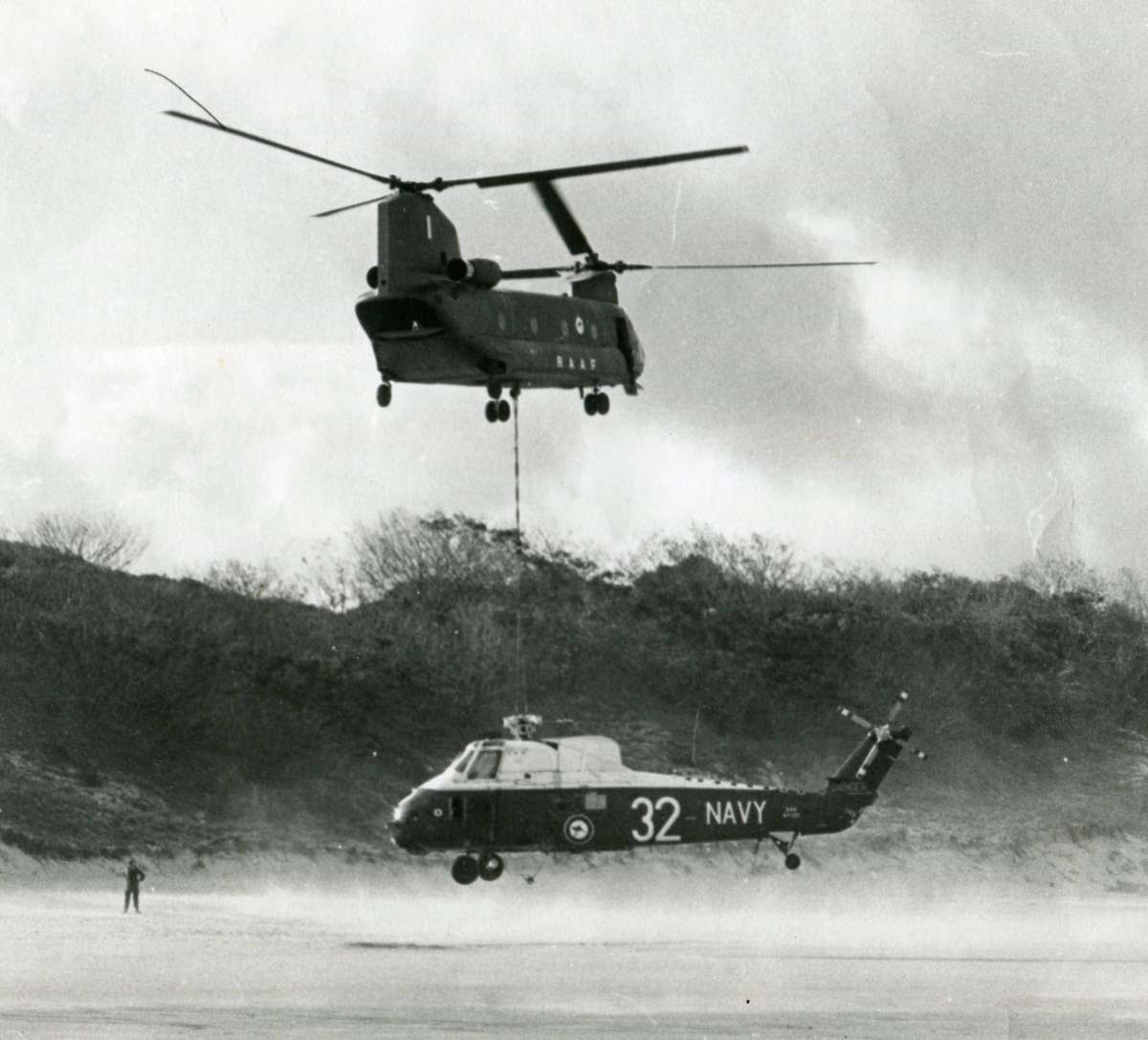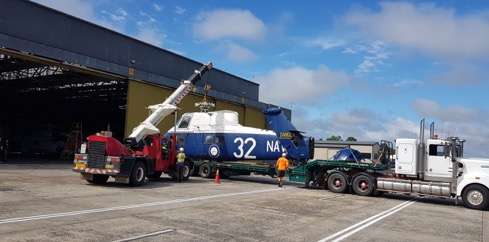Aircraft History:
- First Flight 21/06/63.
- Attached to HMAS Stalwart.
- Crashed 12/11/74 during a forced landing on remote beach at Stockyard Point in the ShoalWater Bay(QLD) training area North of Rockhampton after experiencing a compressor stall at low level. See story below.
- On 04/05/86 embarked in HMAS SUCCESS.
- Used as training aid at RSTT Wagga Wagga.
- 7/12/2015 returned by road to FAA Museum Nowra.
- Nov 2018. Purchased by the Historic Aircraft Restoration Society (HARS).
- Feb 2019. Moved by low loader to HARS facility at Albion Park to undergo restoration as a static display aircraft. See photo below.
 Wessex 31B 832 Forced Landing- Stockyard (North) Beach- 12 November 1974 by Geoff Ledger (copilot)
Wessex 31B 832 Forced Landing- Stockyard (North) Beach- 12 November 1974 by Geoff Ledger (copilot)
In late October 1974, two Wessex 31B helicopters from then HT 725 squadron embarked in HMAS Stalwart for a four week Army exercise in the Shoal Bay region Queensland. I’m not sure why the Wessex were selected, perhaps the Huey’s were grounded for some issue, anyway, it was an exciting and eventful training exercise for the embarked crew.
On this particular day the Flight Commander, LEUT John Leak and myself were flying a low level reconnaissance sortie just to the south of Shoal Bay along Stock Yard (North) beach adjacent to the Byfield National Park. This was about 50 KM from the closest town of Yeppoon. The many readers who have worked on Wessex engines would remember a small issue of the Inlet Guide Vanes ‘wandering’ – a pilots technical term. On this day at low level 100 knots and 100 feet, Wessex N7-222 suffered an engine surge and serious loss of power, which resulted in rapid descent and forced landing on the beach well below the high water mark. As you can see in the photo, the port oleo was smashed and some serious blade tip damage also occurred. Due to our low level, there was no chance to transmit a distress call; this was done after the aircrew egressed the helicopter via our SARBE radio.
We needed to inform ‘Mother’ (HMAS Stalwart) of our predicament. I was detailed off to swim out through the surf to a passing small tinny about 300 metres off shore. Of all my physical attributes at that time, swimming was not high on my strength. Notwithstanding, I made it to the tinny much to the amusement of the two locals who had a reasonable catch of snapper and bream. I asked them to take me to the Stalwart which was about fifteen miles to the north around a couple of headlands. Off we went – a rough old ride and my old mate says half way there we might run out of fuel before we arrive.
Thankfully the tinny makes to the Stalwart, which was at anchor. Also, thankfully it had its ladder way out, so I did a swan dive out of the tinny, and really struggled the last 5 metres to make it to the ladder-way landing as the ship was surging up and down, pushing me away. The POCD grabbed me by the scruff of the neck and dragged me onto the platform, whereby I scrambled up to the midships area where the skipper, Captain Burnside was waiting. He looked at me in amazement and asked where the bloody helicopter was. I nervously replied we had crashed on said beach some distance away. He rolled his eyes and said ‘f**** birdies’.
Stalwart provided some fuel for the tinny to get home. Luckily we had an ATC Officer in the 725 detachment, , Paul Shiels. He managed to contact RAAF Air Command that day and they authorised the first operational Chinook lift in the ADF – fortunately there were two Chooks in the exercise area. The 725 maintenance crew flew to the downed Wessex in our second cab, removed the blades and prepared the helicopter for the lift. The Chinook then lifted the old girl above the high water mark and plonked her down on some tea-tree scrub. It stayed there until the 15th whilst the RAAF formally determined the lifting capacity of the Chinook, when it was lifted to Rockhampton. A replacement Wessex (825) was flown up to Rockhampton two days after the accident.
Below: 832 on the deck of an unknown vessel. Any hints would be appreciated!
Wessex 832 being moved from Nowra to Albion Park airfield to the HARS facility, February 2019. The aircraft is to be restored to ‘static display’ standard.





